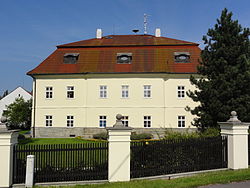Horní Tošanovice
Horní Tošanovice | |
|---|---|
Village | |
 Manor house in Horní Tošanovice | |
 Flag  Coat of arms | |
 Location in the Czech Republic | |
| Coordinates: 49°41′2″N 18°30′53″E / 49.68389°N 18.51472°ECoordinates: 49°41′2″N 18°30′53″E / 49.68389°N 18.51472°E | |
| Country | Czech Republic |
| Region | Moravian-Silesian |
| District | Frýdek-Místek |
| First mentioned | 1305 |
| Government | |
| • Mayor | Petr Martiňák |
| Area | |
| • Total | 5.29 km2 (2.04 sq mi) |
| Elevation | 367 m (1,204 ft) |
| Population (2019)[1] | |
| • Total | 618 |
| • Density | 120/km2 (300/sq mi) |
| Postal code | 739 53 |
| Website | hornitosanovice |
Horní Tošanovice (Polish: Toszonowice Górne) is a village in Frýdek-Místek District, Moravian-Silesian Region, Czech Republic. It has a population of 497 (2006). It lies in the historical region of Cieszyn Silesia.
Etymology[]
The name is patronymic in origin derived from personal name Tosz-. It was variably subscribed in the historical documents: Tessinowitz (1305), Thusnowitz (?, 1316), z Tossinowicz (1445), z Tossonowicz (1447), von Toschonowitz (1523), z Tossynowicz (1536, 1627), z Tossonowicz (1693), na Tossenowiczych (1703), Toschonowice (1724). In the 18th century the distinction between two villages developed. In 1736 both were mentioned as Nieder Toschonowitz (literally Lower; Dolní in Czech, Dolne in Polish, Nieder in German) and Ober Toschonowitz (literally Upper, Horní in Czech, Górne in Polish, Ober in German).[2]
History[]
The village of Tošanovice was first mentioned in a Latin document of Diocese of Wrocław called Liber fundationis episcopatus Vratislaviensis from around 1305 as item in Tessinowitz.[3][4][5] It meant that the village was in the process of location (the size of land to pay a tithe from was not yet precised). The creation of the village was a part of a larger settlement campaign taking place in the late 13th century on the territory of what will be later known as Upper Silesia.
Politically the village belonged initially to the Duchy of Teschen, formed in 1290 in the process of feudal fragmentation of Poland and was ruled by a local branch of Piast dynasty. In 1327 the duchy became a fee of the Kingdom of Bohemia, which after 1526 became part of the Habsburg Monarchy.
After Revolutions of 1848 in the Austrian Empire a modern municipal division was introduced in the re-established Austrian Silesia. The village as a municipality was subscribed to the political and legal district of Cieszyn. According to the censuses conducted in 1880, 1890, 1900 and 1910 the population of the municipality grew from 460 in 1880 to 472 in 1910 with a majority being native Polish-speakers (52.2% in 1880, later between 88% and 93.1%) accompanied by a Czech-speaking minority (46% in 1880, later between 6.1% and 9.5%) and German-speaking (at most 8 or 2.5% in 1900). In terms of religion in 1910 the majority were Roman Catholics (74.8%), followed by Protestants (25.2%).[6]
After World War I, fall of Austria-Hungary, Polish–Czechoslovak War and the division of Cieszyn Silesia in 1920, it became a part of Czechoslovakia. Following the Munich Agreement, in October 1938 together with the Zaolzie region it was annexed by Poland, administratively adjoined to Cieszyn County of Silesian Voivodeship.[7] It was then annexed by Nazi Germany at the beginning of World War II. After the war it was restored to Czechoslovakia.
See also[]
- Polish minority in the Czech Republic
- Zaolzie
References[]
- ^ "Population of municipalities of the Czech Republic". Czech Statistical Office. 1 January 2019.
- ^ Mrózek, Robert (1984). Nazwy miejscowe dawnego Śląska Cieszyńskiego [Local names of former Cieszyn Silesia] (in Polish). Katowice: Uniwersytet Śląski w Katowicach. p. 175. ISSN 0208-6336.
- ^ Panic, Idzi (2010). Śląsk Cieszyński w średniowieczu (do 1528) [Cieszyn Silesia in the Middle Ages (until 1528)] (in Polish). Cieszyn: Starostwo Powiatowe w Cieszynie. pp. 297–299. ISBN 978-83-926929-3-5.
- ^ Schulte, Wilhelm (1889). Codex Diplomaticus Silesiae T.14 Liber Fundationis Episcopatus Vratislaviensis (in German). Breslau.
- ^ "Liber fundationis episcopatus Vratislaviensis" (in Latin). Retrieved 13 July 2014.
- ^ Piątkowski, Kazimierz (1918). Stosunki narodowościowe w Księstwie Cieszyńskiem (in Polish). Cieszyn: Macierz Szkolna Księstwa Cieszyńskiego. pp. 265, 283.
- ^ "Ustawa z dnia 27 października 1938 r. o podziale administracyjnym i tymczasowej organizacji administracji na obszarze Ziem Odzyskanych Śląska Cieszyńskiego". Dziennik Ustaw Śląskich (in Polish). Katowice. nr 18/1938, poz. 35. 31 October 1938. Retrieved 1 July 2014.
External links[]
- (in Czech) Official website
- Populated places in Frýdek-Místek District
- Villages in Frýdek-Místek District
- Cieszyn Silesia
- Moravian-Silesian Region geography stubs



